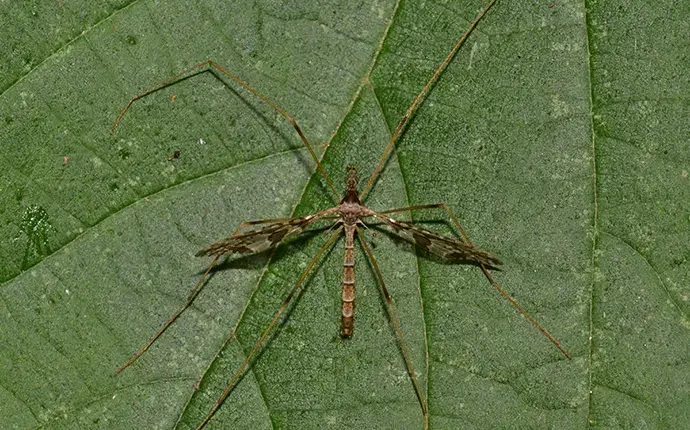
Crane Flies
While they are often mistaken for mosquitoes thanks to their long legs and delicate wings, crane flies are harmless to humans—they don’t bite or sting. Still, these insects can become a nuisance and cause damage to turfgrass in certain life stages, so it’s important to know how to spot an infestation as soon as you have one.
How to Identify Crane Flies
Crane flies are most easily recognized by their long, slender bodies and characteristic antennae. These insects are often confused with mosquitoes due to their similar shape, but crane flies are significantly larger and completely non-threatening to humans.
Attracted to light, crane flies are frequently seen around porch lights, especially in late summer or fall. They thrive in areas with moisture, such as near ponds, streams, and other water sources making them a common sight in North Carolina.
Habitat and Diet
Crane flies prefer environments with ample moisture and vegetation, particularly near water. Their life stages have distinct dietary habits and environmental preferences:
- Adult crane flies don’t feed, as their primary role is reproduction. Their lifespan as adults lasts only a few days.
- Crane fly larvae, on the other hand, can be up to 2 inches long and are voracious feeders, consuming decaying organic material and the roots of grasses. These larvae can cause significant damage to turfgrass, leaving brown patches on lawns or affecting crops.

Lifecycle and Behavior
Adult crane flies have a short lifespan, yet they reproduce quickly. Female crane flies can lay up to 300 eggs in moist soil within days of emerging. These eggs hatch into larvae, leading to a potentially large population in a short period of time.
Larvae are most active during the spring months, feeding on plant material. By early June, they complete their development and burrow about three inches into the soil to pupate, preparing for the next generation of adults.
These larvae, known as "leatherjackets," can cause substantial damage to turfgrass by feeding on the shoots, crowns, and roots during early spring.
Dangers of a Crane Fly Infestation
Crane fly infestations can pose significant challenges for homeowners, gardeners, and farmers.
Damage to Turf and Crops
One of the most frustrating parts of a crane fly infestation is the damage to turfgrass and crops. The larvae feed on the roots, crowns, and shoots of plants, which weakens the vegetation and can lead to brown patches on lawns, declining crop yields, and weakening of pasture grass.
Quick Reproduction and Spread
The rapid reproduction cycle of crane flies contributes to their danger. Female crane flies can lay up to 300 eggs in moist soil, leading to a rapid population increase. Without intervention, infestations can spread quickly, affecting larger areas and causing widespread damage.
Long-Term Impact on Ecosystems
Over time, an unchecked crane fly infestation can lead to weakened plant ecosystems. By damaging the roots and preventing healthy plant growth, larvae create conditions that are ripe for soil erosion and loss of biodiversity in gardens, lawns, and agricultural environments.
Crane Fly Prevention and Control Strategies
Effectively managing crane fly populations requires a combination of cultural, environmental, and biological strategies.
Mowing and Irrigation Techniques
Proper lawn care is essential for reducing crane fly populations. That includes:
- Mow regularly and appropriately: Mow your lawn once a week, making sure to keep a height of 2 to 3 inches. This height encourages healthy grass growth while making it less attractive to crane fly larvae.
- Recycle grass clippings: Returning grass clippings to your lawn reduces the need for additional fertilizer by naturally replenishing nutrients in the soil.
- Water strategically: Apply approximately 0.25 inches of water four times per week from Memorial Day to Labor Day. Adjust this amount based on weather conditions and soil moisture levels to avoid creating overly wet environments, which are favorable for crane fly larvae.
Improving Soil Drainage and Fertilization
Maintaining well-drained soil and properly fertilizing your lawn can significantly reduce crane fly populations.
- Enhance soil drainage: Crane fly eggs and young larvae thrive in wet soil. Improving soil drainage during these early stages increases mortality rates, helping to control the population naturally.
- Strategic fertilization: Turfgrass species like perennial ryegrass and Kentucky bluegrass benefit from two fertilizer applications in the spring and two in the fall. Use a fertilizer with high nitrogen, low phosphorus, and moderate potassium levels to ensure strong, healthy grass growth that resists crane fly damage.
Encouraging Natural Predators
Finally, when in doubt, turn to mother nature herself:
- Attract birds and other predators: Birds, amphibians, and beneficial insects are natural enemies of crane flies. Create a welcoming environment by providing food sources, shelter, and water to encourage these predators to visit your yard.
- Utilize biological control methods: Introducing natural predators like nematodes specifically designed to target crane fly larvae can significantly reduce their numbers. These biological controls are safe for the environment and other wildlife.
Encouraging a balanced ecosystem reduces reliance on chemical treatments and helps keep crane fly populations in check naturally.
FAQ
When are crane flies most prevalent?
The best time to scout for crane flies is in November, December, and January when larvae are most active. Focus on low-lying areas where water pools or the soil remains saturated, as these environments attract crane flies.
Look for signs of larvae, such as damaged grass patches or the presence of crane fly larvae.
What are common mistakes to avoid in DIY crane fly control?
There are a few major mistakes we see people make over and over when it comes to crane fly control:
- Overusing insecticides: Overuse can lead to the development of resistant crane fly populations. Use insecticides only when necessary and always follow the label instructions carefully.
- Ignoring underlying issues: Poor soil drainage and improper fertilization contribute to crane fly infestations. Address these factors to reduce the likelihood of recurring problems.
Do crane flies attract other pests?
Yes, crane flies can attract birds and small mammals that feed on their larvae. These secondary pests can cause additional damage to turf and crops.
What secondary damage can crane fly infestations cause?
Crane fly infestations can lead to fungal diseases in your lawn and attract other pests. Monitoring your lawn closely and taking preventative measures can help mitigate these secondary issues.
Contact A-1 Pest Control for Crane Fly Control
By combining effective control methods, such as proper mowing and irrigation practices, targeted use of insecticides, and biological control techniques, you can manage infestations and protect your lawn. We use environmentally responsible methods to control crane flies and prevent their return.
If you're dealing with a crane fly infestation or need guidance on prevention, our expert pest control team is here to help. Contact A-1 Pest Control today at 828-481-9140 or fill out the form below for a professional pest control plan tailored to your needs!

